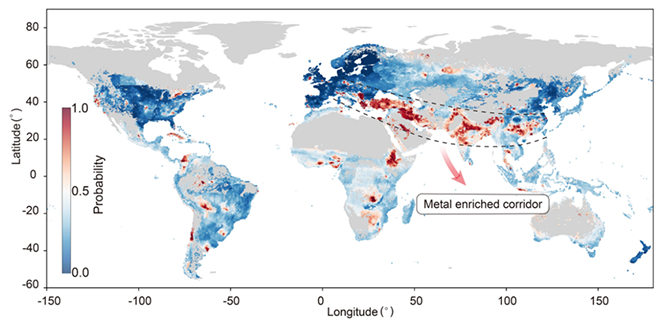Chinese Scholars and International Collaborators Make Progress in Soil Heavy Metal Pollution Research

Figure: Global soil pollution by toxic metals exceeding agricultural thresholds
Supported by the National Natural Science Foundation of China (Young Scientist Fund-A; Grant No. 42225703), the research team led by Professor Deyi Hou from Tsinghua University, in collaboration with international partners, has achieved progress in the field of soil heavy metal pollution. The study, entitled "Global Soil Pollution by Toxic Metals Threatens Agriculture and Human Health," was published online in Science on April 17, 2025. Paper link: https://www.science.org/doi/10.1126/science.adr5214.
Vadose zone and saturated aquifer are critical components of the Earth’s critical zone. Their contamination processes are major research topics in environmental geoscience, closely tied to food security, human health, and ecological safety. In recent years, soil heavy metal pollution has gained global attention due to its widespread distribution and persistent hazards. However, a comprehensive understanding of the spatial heterogeneity and formation mechanisms of global soil toxic metal pollution remains lacking. Of particular note is the distinction between Northern and Southern Europe divided by 55° N latitude in terms of metal abundance. While some researchers have attributed this phenomenon to the last glaciation, the underlying mechanisms remain an unresolved scientific puzzle.
To address this research gap, Professor Hou’s team developed a novel model for predicting heavy metal exceedance distributions in soils by integrating big data analytics with extremely randomized trees machine learning algorithm. For the first time, the study revealed a transcontinental "metal-enriched corridor" spanning low-latitude Eurasia, shaped by the synergistic effects of climate, topography, and anthropogenic activities. This corridor is regarded as a keystone indicator of the Anthropocene era.
Using machine learning and structural equation modeling, the research demonstrated that the global distribution of heavy metals in shallow soils results from cross-media transfer processes (e.g., surface water irrigation, groundwater leaching) and complex environmental-socioeconomic interactions. The intercontinental "metal-enriched corridor", extending from Southern Europe through the Middle East to South Asia and Southern China, spatially overlaps with major cradles of ancient civilizations (ancient Greek, the Roman Empire, Persian, ancient India, and Yangtze River Chinese culture). Its formation mechanism traces back to millennia of sustained mining and smelting activities, coupled with natural factors such as parent rock weathering, plant-pump effects, and unique mountainous terrain.
For the first time, the study mapped the global distribution of seven toxic metals/metalloids (arsenic, cadmium, cobalt, chromium, copper, nickel, and lead) in soil. Results indicate that 14% to 17% of cropland is affected by toxic metal pollution globally, posing risks to food security, while 0.9 billion to 1.4 billion people live in regions of heightened public health and ecological risks. This work systematically elucidates the formation mechanisms of large-scale soil pollution, providing a robust theoretical framework, innovative methodologies, and foundational data to support global soil heavy metal pollution mitigation.
Contact Us

National Natural Science Foundation of China
Add: 83 Shuangqing Rd., Haidian District, Beijing, China
Postcode: 100085
Tel: 86-10-62327001
Fax: 86-10-62327004
E-mail: bic@nsfc.gov.cn
